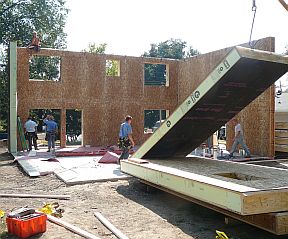 What is a Passive House?
What is a Passive House?
The passive house concept was pioneered in the Northern U.S. and Canada in the late 1970s and early 1980s when it was called “superinsulation”. European builders have improved the superinsulation technology and applied it to both single-family dwellings and apartments. The Passive House founders, including Dr. Wolfgang Feist, believe that reducing building energy consumption to one-tenth of its current amount is both cost-effective and morally imperative. Architect Katrin Klingenberg is the founder of the Passive House Institute USA.
Defining the Passive House
The most unique feature of a Passive House is that it’s designed to be conditioned by ventilation air. So if the maximum ventilation that a 2000 square foot home requires is 120 CFM, then that amount of airflow must also carry the heating and cooling to the home’s rooms. In a standard American home the airflow would be around 1200 CFM. 12o CFM isn’t very much airflow and it won’t carry much heat to or from the rooms. This one performance standard necessitates R-values above 40 all the way around the building and an airtight building shell. The additional Passive House standards simply reinforce the challenge issues by limiting the airflow.
Summary of Passive House Requirements
Here is a summary of the physical requirements for Passive House certification for a new home.
Install no more than 1 watt of heating per square foot of floor space.
- Use no more than 1.5 kWh per square foot of floor space for heating annually.
- Use no more than 4 annual kWh per square foot annually for all home energy.
- Construct an airtight building shell (0.6 ACH50 or around 0.03 ACHn) *
- Install a heat-recovery or energy-recovery ventilator. Use the ventilation air to deliver heating and cooling: 15-30 cfm/person
- Use renewable energy whenever possible to satisfy these loads.
For more information, see The Homeowners Handbook to Energy Efficiency or go to the Passivehouse Institute USA website.


Thanks for the comments and corrections.
There is no reguirement for the ventilation air and the heating and cooling to be carried by the venitation air. Every climate requires its own analysis of systems that most cost effectively and efficiently deliver the small amount of conditioning needed for the space.
In europe where Passive house got its start this is the best way to achieve the standard. In Minnesota it would not since you can only deliver so much heat in the same ducts as venitlation air without burning the dust in the ducts.
Us a qualified CPHC, Certified Passive House COnsultant to plan your building. THey will know how to maximize the value by planning and designing with knowlege of best practics, best materials and maximizing the synergies between systems.
Great post, except note:
Passive House can reduce *heating* energy to ten per cent of a building built to the 2006 International Residential Code, but *total* energy use–which also includes plug loads and energy factors for energy generation and transmission, which can be significant–is reduced by “only” seventy per cent or so. Still substantial, cost effective, and morally imperative!
The requirement for all home energy is 11 kWh/SF/year, or 38 kBtu/SF/year. (Not 4 kWh/SF/year.)
Renewable energy is often chosen for Passive House projects, because with the greatly reduced demand it becomes much more affordable, but it is not a requirement of the Passive House standard.
Early Passive House projects were designed to be heated by conditioned air, but in current projects the heating is often separated from the ventilation.
More here: http://www.phaus.org/learn/passive-house-education/what-is-passive-house-